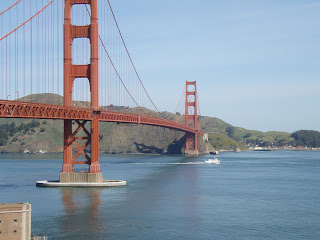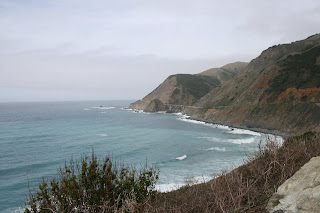Busy, busy day—we are both exhausted!
This morning we took a bus tour of San Francisco. We have explored San Francisco several times on our own, but thought it would be fun to take an official tour. Since Tom always drives, he never gets to see as much as I do while he is navigating the crazy California traffic. This gave Tom a chance to sit back, relax, and enjoy the sights.
We got into the city way earlier than we planned, as it was a state holiday (Caesar Chavez Day) which we had not realized. There was virtually no traffic on the way in during what should have been morning rush hour. We found a Starbucks, which is never difficult to do in California, and people watched for a bit until tour time. We were near a cable car terminal, and watched them turn the cars around, which they do manually.
Walking to the bus station, we saw a tall ship (formerly known as the Star of Alaska) in the bay, in front of Alcatraz Island.

I think we covered every neighborhood and district in the city on the bus tour. We certainly saw some areas we had never seen before. Our travels included Pacific Heights, Sea View, Twin Peaks, Haight Ashbury, North Point, Chinatown, the Italian section (the name escapes me), the Presidio, Golden Gate Park, and more that I am forgetting. The bus driver had a wicked sense of humor and was fun as well as informative. Tom did feed him a line or two that he then took off and expanded. 

Golden Gate Bridge as seen from the Twin Peaks observation site.
Besides the standard tour places, we did see a couple of celebrity places, which is always fun. We saw the house where the Grateful Dead lived and where Jimmy Hendricks stayed when Haight Ashbury was the place to be. Also saw the block long house in Pacific Heights (a not too shabby address) that Danielle Steele lives in at present. I can’t begin to imagine what a place that huge and beautiful must cost in San Francisco. Robin William’s house was nearby, but on a street tour buses are forbidden to travel.
The tour was a delight in spite of a know-it-all woman who sat directly behind the driver and attempted to give her own tour patter. I think the entire bus could have gladly strangled her. The drive did nicely quiet her down.
I think Tom took a million pictures. I’m sure he will be posting them soon.
After a lunch from a hot dog vendor on the street (it was available and safe), we set out for Pier 33 and the Alcatraz tour. The island is about one mile offshore and is accessed by multi-decked ferries. Of course we had to ride on the top level so Tom could shoot pictures all the way there. We about froze to death and Tom almost lost his hat, but it was fun.
The tour was a delight in spite of a know-it-all woman who sat directly behind the driver and attempted to give her own tour patter. I think the entire bus could have gladly strangled her. The drive did nicely quiet her down.
I think Tom took a million pictures. I’m sure he will be posting them soon.
After a lunch from a hot dog vendor on the street (it was available and safe), we set out for Pier 33 and the Alcatraz tour. The island is about one mile offshore and is accessed by multi-decked ferries. Of course we had to ride on the top level so Tom could shoot pictures all the way there. We about froze to death and Tom almost lost his hat, but it was fun.
 Ruins of warden's house on Alcatraz Island and barracks that date back to Civil War period when the Island was a military defense site and prisoner of war camp.
Ruins of warden's house on Alcatraz Island and barracks that date back to Civil War period when the Island was a military defense site and prisoner of war camp.The tour is interesting, but very sobering. They have scripted a marvelous tour you listen to on ear phones with individual control units (several languages are available—we chose English). There are descriptions of life in the prison, and interviews with actual former prisoners, guards, and people who lived on the island as children. (Guards’ families lived in a small town community right on the island, with their own store, school, and recreational facilities.). The parts that were done by actors were well cast.
The narrations and stories were complete with sound effects. I saw more than one person look around startled at the sound of a slamming cell door or an alarm going off in their headset. It seemed all too real. As you listened, you walked the cell blocks and other areas of the prison, looking at the actual places where it happened. Many of the cells were “furnished” exactly as they had been when occupied. I cannot imagine living that way. Several of the prisoners’ stories were of what they did to keep from going insane.
Some of the cells are open so that you can go inside. It is not a nice feeling, even though you know you can walk back out at will.
The narrations and stories were complete with sound effects. I saw more than one person look around startled at the sound of a slamming cell door or an alarm going off in their headset. It seemed all too real. As you listened, you walked the cell blocks and other areas of the prison, looking at the actual places where it happened. Many of the cells were “furnished” exactly as they had been when occupied. I cannot imagine living that way. Several of the prisoners’ stories were of what they did to keep from going insane.
Some of the cells are open so that you can go inside. It is not a nice feeling, even though you know you can walk back out at will.

The cells are incredibly small and sparse.

Yes, they did have the cells of the three who escaped through the vents and made the rafts out of rain coats, as per the movie. The cots were made up with the fake heads, and the vent covers removed so you could see how they enlarged them—with spoon handles no less. It is estimated it took a year to accomplish. No one is sure whether they survived or not, but there is no proof that they did, so it doesn’t count as a bona fide escape. However, the prisoners who were there at the time swear they made it to South America. They had been studying Spanish.(Prisoners could, with good behavior, earn the right to take correspondence courses. There was also a large library that was used by many of them, with philosophy being one of the most popular topics.)
I did not realize that only “incorrigibles” were sent to Alcatraz. Prisoners who could not be controlled anywhere else were sent there. Years of proper (i.e. following the rules to a “T“) could get them a transfer out. There was one interview with a bank robber who said that his four years there changed his life and turned him around—but he was the only person to speak positively about the experience of living on the rock.
Apparently when Al Capone was there, he was known as still being a nasty street fighter, but due to tertiary syphilis, he had very little mind left. They considered him insane, and he probably was. He did die from the disease.
One interesting thing for me was that the prisoners invented a form of Bridge, played by individuals without partners, using domino tiles instead of cards. It became an obsession with many prisoners and they would sit outside in the recreation yard on all kinds of weather and play for three hours at a time.
View of San Francisco from Alcatraz Island. This is the the view the prisoners saw of a world that they no longer had any part of, but could still hear faint sounds from when the wind blew in from the city.

It was interesting, but I was more than ready to board the ferry for the trip back.

 We saw Egyptian statues over 3500 years old (King Tut’s dynasty, but not from his tomb), sarcophagi, Roman columns, 14th century tapestries, seats and a wooden ceiling scavenged from monasteries and convents in Europe, paintings hundreds of years old, hand crafted silver, and a host of other collectibles. There is so much gathered and displayed so closely together that you at times lose the sense of beauty of each piece. That much money and power is hard to absorb, the mind boggles.
We saw Egyptian statues over 3500 years old (King Tut’s dynasty, but not from his tomb), sarcophagi, Roman columns, 14th century tapestries, seats and a wooden ceiling scavenged from monasteries and convents in Europe, paintings hundreds of years old, hand crafted silver, and a host of other collectibles. There is so much gathered and displayed so closely together that you at times lose the sense of beauty of each piece. That much money and power is hard to absorb, the mind boggles. 









 In addition to the little ones, there were a couple of older juveniles who acted much like human teenagers. As everyone else was settling down for naps, they sere antsy and kept changing places, then deciding to go for a swim, then returning to annoy their elders. The annoyed adults rolled on a side and waved a flipper at them in a “go away” kind of motion.
In addition to the little ones, there were a couple of older juveniles who acted much like human teenagers. As everyone else was settling down for naps, they sere antsy and kept changing places, then deciding to go for a swim, then returning to annoy their elders. The annoyed adults rolled on a side and waved a flipper at them in a “go away” kind of motion.































